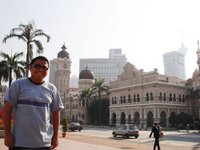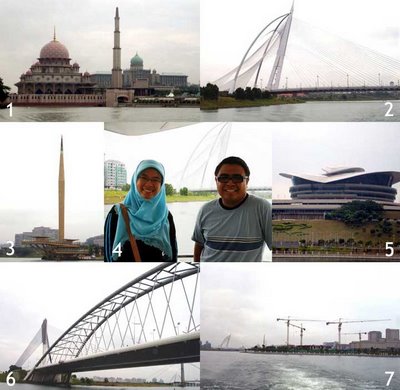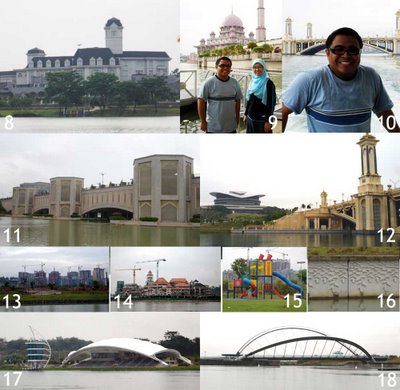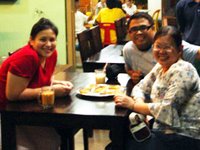 Pampanga's pride is indeed its heritage and cuisine. I got a lot of texts yesterday since my blog was mentioned in the article Hit the Road in 2bU in the Inquirer Lifestyle section. And people had been calling the Center for Kapampangan Studies for information. Anyway, the article information was based on entries 9 and 10 of my blog.
Pampanga's pride is indeed its heritage and cuisine. I got a lot of texts yesterday since my blog was mentioned in the article Hit the Road in 2bU in the Inquirer Lifestyle section. And people had been calling the Center for Kapampangan Studies for information. Anyway, the article information was based on entries 9 and 10 of my blog.Just some corrections, what was mentioned as Furniture Clay (yes we had callers asking about the clay furniture) is actually Furniture City in Mabalacat, Pampanga. This is a complex of world-class furniture factories which export their products worldwide. Before you visit, please call Lisa Samia at (045) 8930092 to 93.
 Abe's Farm is actually the Mt. Arayat resthouse of restaurateur Larry Cruz of the LJC Restaurant Group which includes Cafe Adriatico and Cafe Havana among many others. The fabulous resthouse is in Magalang, Pampanga, the hometown of Larry's father, journalist and artist E. Aguilar Cruz. Having lunch at his place requires arrangements made much earlier though (photo of buffet table is on the left). For more information, click here.
Abe's Farm is actually the Mt. Arayat resthouse of restaurateur Larry Cruz of the LJC Restaurant Group which includes Cafe Adriatico and Cafe Havana among many others. The fabulous resthouse is in Magalang, Pampanga, the hometown of Larry's father, journalist and artist E. Aguilar Cruz. Having lunch at his place requires arrangements made much earlier though (photo of buffet table is on the left). For more information, click here.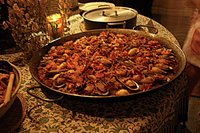 Another must try lunch or dinner venue is Claude Tayag's residence Bale Dutung in Villa Gloria, Angeles City. This P1800 per head Kapampangan feast has to be pre-arranged as well and you must have at least 12 persons in your group (photo of Claude's paella is on the right). Claude has a shop in his house where you can buy bottled buro and taba ng talangka but the Claude 9 brand is also available in Pampanga supermarkets such as Essel Supermarket. You can also pass by Tita's or Pampanga's Best along Gapan-Olongapo Road for even more Kapampangan delicacies.
Another must try lunch or dinner venue is Claude Tayag's residence Bale Dutung in Villa Gloria, Angeles City. This P1800 per head Kapampangan feast has to be pre-arranged as well and you must have at least 12 persons in your group (photo of Claude's paella is on the right). Claude has a shop in his house where you can buy bottled buro and taba ng talangka but the Claude 9 brand is also available in Pampanga supermarkets such as Essel Supermarket. You can also pass by Tita's or Pampanga's Best along Gapan-Olongapo Road for even more Kapampangan delicacies.C Italian Restaurant is among the many international offerings that line Fields Avenue and Friendship Highway beside Clark. You can check out Zapata's (Mexican), Salvatore's (Italian), Subdelicious (American), Cottage Kitchen (Cajun), and a host of Japanese and Korean restaurants among many others.
 The ensaymadas in San Fernando are made-to-order and you have to call them at least 2 days in advance. But Imang Salud Dayrit's San Fernando ensaymadas are actually available in Manila. These melt-in-your-mouth wonders are six inches in diameter, made with the finest ingredients and topped with a generous serving of queso de bola. You can visit the Legaspi Sunday Market organized by San Lorenzo Village and open every Sunday from 7:30 a.m. to 2 p.m. behind the Corinthian Plaza building. Make sure you look for the Imang Salud booth. Also on sale are atcharang gule, atcharang ubud, balu-balo, tibok-tibok and pickled mangoes. Another signature dessert but made-to-order is plantanilla, sweet egg crepes with latik filing. Yummy! You can call (0920) 9478819 for orders.
The ensaymadas in San Fernando are made-to-order and you have to call them at least 2 days in advance. But Imang Salud Dayrit's San Fernando ensaymadas are actually available in Manila. These melt-in-your-mouth wonders are six inches in diameter, made with the finest ingredients and topped with a generous serving of queso de bola. You can visit the Legaspi Sunday Market organized by San Lorenzo Village and open every Sunday from 7:30 a.m. to 2 p.m. behind the Corinthian Plaza building. Make sure you look for the Imang Salud booth. Also on sale are atcharang gule, atcharang ubud, balu-balo, tibok-tibok and pickled mangoes. Another signature dessert but made-to-order is plantanilla, sweet egg crepes with latik filing. Yummy! You can call (0920) 9478819 for orders.But one thing the article was not able to mention (since it wasn't in my blog article) was Everybody's Cafe where Kapampangan food is available everyday in their turo-turo style display. Try out the pako salad, calderetang baka, morcon, chicharon bulaklak, tortang bangus, inihaw na hito or bulalo soup. For the brave, go further and savor the buro with hito (fermented fish paste with catfish), betute (deep-fried stuffed frog), camaru (fried cricket adobo), dumara (wild duck adobo) or pindang damulag (carabeef tapa). They have branches in San Fernando along MacArthur Highway in Barangay Del Pilar, and Angeles City in Nepo Mart.
Other must tries are the Kapampangan halo-halo places. In fact, there are three distinct halo-halo varieties in Pampanga. These are Guagua (Razon’s), Angeles (Corazon’s) and Arayat (Kabigting's and Jurado's) halo-halo. It must also be noted that Kapampangan halo-halo is distinct from the other halo-halo served in the country because it uses only three or four ingredients or sahog. However, the richness of these ingedients more than compensates for the number of types thrown in the glass. Arayat for example is distinct for its pastillas, crushed beans and saging combination; Guagua for its macapuno, saging, and leche flan; while Angeles is distinct for its mais, saging, pastillas and crushed beans combination.
 Also check out Aling Lucing's at the Crossing (Henson Street, Angeles City) which is the birthplace of Pampanga sisig and the steakhouses in Marisol Subdivision, Angeles City. Luring's of Guagua (with branches all over Pampanga) serves some of the best barbeque and other grilled meat products. Ikabud (the contracted form of ika kabud which translates as only you) is another restaurant that serves grilled food and is located in Hensonville, Angeles City.
Also check out Aling Lucing's at the Crossing (Henson Street, Angeles City) which is the birthplace of Pampanga sisig and the steakhouses in Marisol Subdivision, Angeles City. Luring's of Guagua (with branches all over Pampanga) serves some of the best barbeque and other grilled meat products. Ikabud (the contracted form of ika kabud which translates as only you) is another restaurant that serves grilled food and is located in Hensonville, Angeles City.If you want to try out everything, go for Smorgasbord, the buffet Kapampangan lunch and dinner offered at Partyland (MacArthur Highway and SM City Pampanga) and Holidayland (Gapan-Olongapo Road) both in San Fernando.
 Visiting Pampanga has now been made easier and carefree with a tour entiled Pampanga's Pride offered through the Island Caravan. Visit their website for more information or e-mail skoal@skyinet.net.
Visiting Pampanga has now been made easier and carefree with a tour entiled Pampanga's Pride offered through the Island Caravan. Visit their website for more information or e-mail skoal@skyinet.net.The tour includes a visit to...
- Bacolor Church - this is the half-buried San Guillermo Church in Bacolor. Entering what was once the largest church in Pampanga, visitors enter the church through the choirloft windows, and are greeted inside by beautifully restored retablos dug up from several feet of lahar. The citizens of Bacolor take pride in their rich heritage which is why they painstakingly excavated the ornately carved wooden main and side altars which are now back to their pristine condition;
- Betis Church - a must visit church in Pampanga, the centuries-old Betis Church in Guagua is nicknamed the "Sistine chapel of the Philippines" because of its wall ceiling murals. It is the second oldest church in Pampanga and one of the 26 churches declared by the National Museum as national cultural treasures;
- Archdiocesan Museum and Archives - savor the grandeur and elegance of religious art in Pampanga with a visit to the repository of Pampanga's church treasures housed inside the University of the Assumption; and
- Center for Kapampangan Studies - a museum, archives, library, research center and theater rolled into one, the Center for Kapampangan Studies was put up by Holy Angel University in 2002 to preserve, study and promote Kapampangan history and culture
For those who could afford to splurge, go for the overnight tour package which includes dinner at Claude Tayag's Bale Dutung, lunch the next day at Abe's Farm of Larry Cruz, and overnight accomodations at King's Royal Hotel and Resort.
 Above are some photos of the natural heritage of Pampanga which I took way back in college in 2001 and 2002.
Above are some photos of the natural heritage of Pampanga which I took way back in college in 2001 and 2002.

